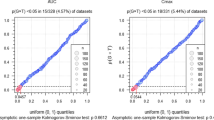Abstract
Residual error models, traditionally used in population pharmacokinetic analyses, have been developed as if all sources of error have properties similar to those of assay error. Since assay error often is only a minor part of the difference between predicted and observed concentrations, other sources, with potentially other properties, should be considered. We have simulated three complex error structures. The first model acknowledges two separate sources of residual error, replication error plus pure residual (assay) error. Simulation results for this case suggest that ignoring these separate sources of error does not adversely affect parameter estimates. The second model allows serially correlated errors, as may occur with structural model misspecification. Ignoring this error structure leads to biased random-effect parameter estimates. A simple autocorrelation model, where the correlation between two errors is assumed to decrease exponentially with the time between them, provides more accurate estimates of the variability parameters in this case. The third model allows time-dependent error magnitude. This may be caused, for example, by inaccurate sample timing. A time-constant error model fit to time-varying error data can lead to bias in all population parameter estimates. A simple two-step time-dependent error model is sufficient to improve parameter estimates, even when the true time dependence is more complex. Using a real data set, we also illustrate the use of the different error models to facilitate the model building process, to provide information about error sources, and to provide more accurate parameter estimates.
Similar content being viewed by others
References
G. A. F. Seber and C. J. Wold.Nonlinear Regression, J. Wiley, New York, 1989.
E. M. Chi and G. C. Reinsel. Models for longitudinal data with random effects and AR (1) errors.J. Am. Statist. Assoc. 84:452–459 (1989).
M. Davidian and D. M. Giltinan. Some general estimation methods for nonlinear mixed-effects models.J. Biopharm. Statist. 3:23–55 (1993).
J. Beran. Statistical method for data with long-range dependence.Statist. Sci. 7:404–407 (1992).
C. A. Glasbey. Correlated residuals in non-linear regression applied to growth data.Appl. Statist. 28:251–259 (1979).
D. Ruppert, N. Cressie, and R. J. Carroll. A transformation/weighting model for estimating Michaelis-Menten parameters.Biometrics 45:637–656 (1989).
C. A. DeBoor.A Practical Guide to Splines. Springer-Verlag, New York, 1978.
H. Akaike. A new look at the statistical model identification.IEEE Trans. Automat. Contr. 19:716–723 (1974).
NONMEM User's Guides. NONMEM Project Group, University of California, San Francisco, 1992.
J. W. Mandema, D. Verotta, and L. B. Sheiner. Building population pharmacokinetic-pharmacodynamic models: I. Models for covariate effects.J. Pharmacokin. Biopharm.20:511–528 (1992).
M. O. Karlsson and L. B. Sheiner. The importance of modeling interoccasion variability in population pharmacokinetic analyses.J. Pharmacokin. Biopharm. 21:735–750 (1993).
S-PLUS, version 3.1. Statistical Sciences, Inc., P.O. Box 85625, Seattle, WA, 1990.
Author information
Authors and Affiliations
Additional information
This work was supported by grants GM26676 and GM2669
Rights and permissions
About this article
Cite this article
Karlsson, M.O., Beal, S.L. & Sheiner, L.B. Three new residual error models for population PK/PD analyses. Journal of Pharmacokinetics and Biopharmaceutics 23, 651–672 (1995). https://doi.org/10.1007/BF02353466
Received:
Accepted:
Published:
Issue Date:
DOI: https://doi.org/10.1007/BF02353466




